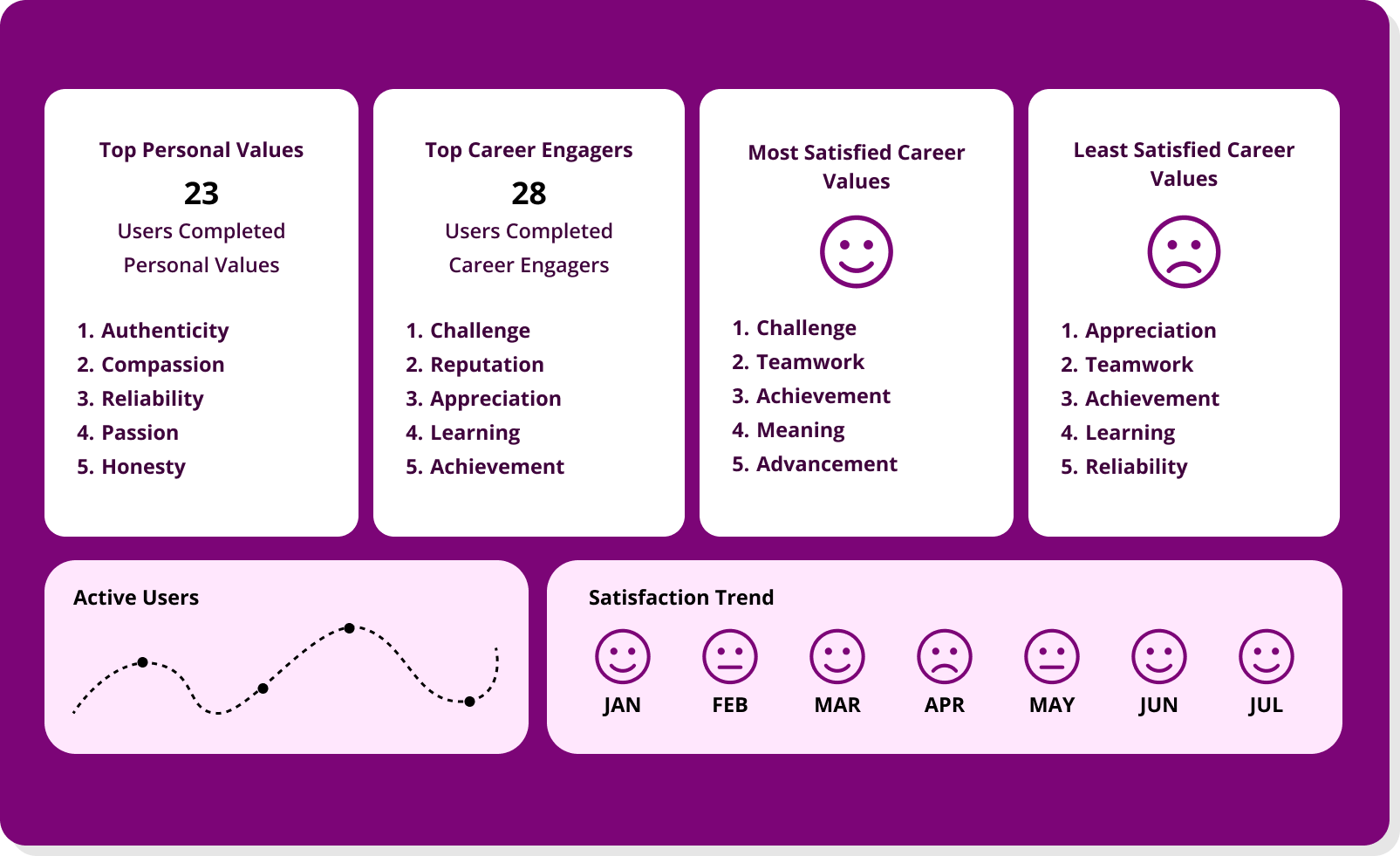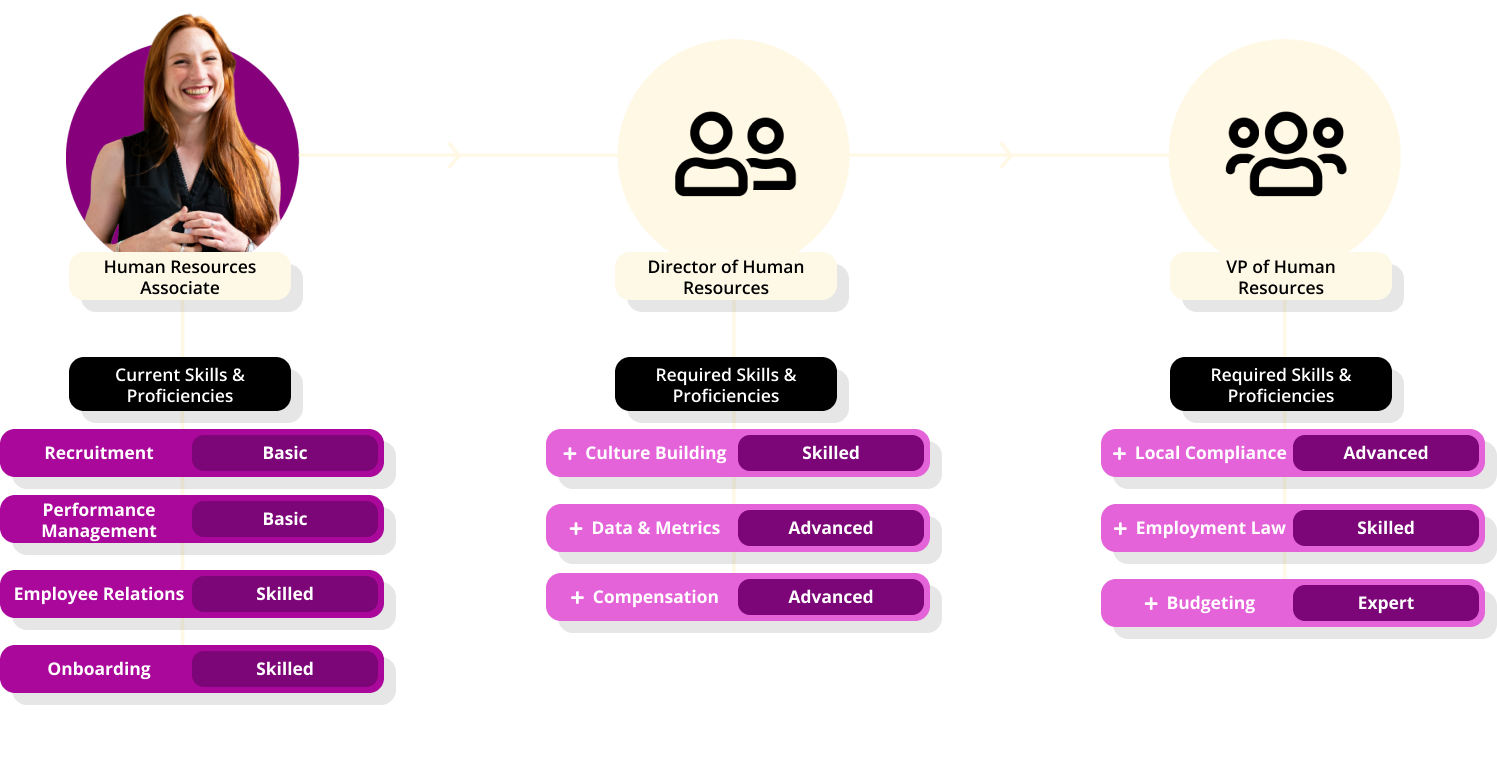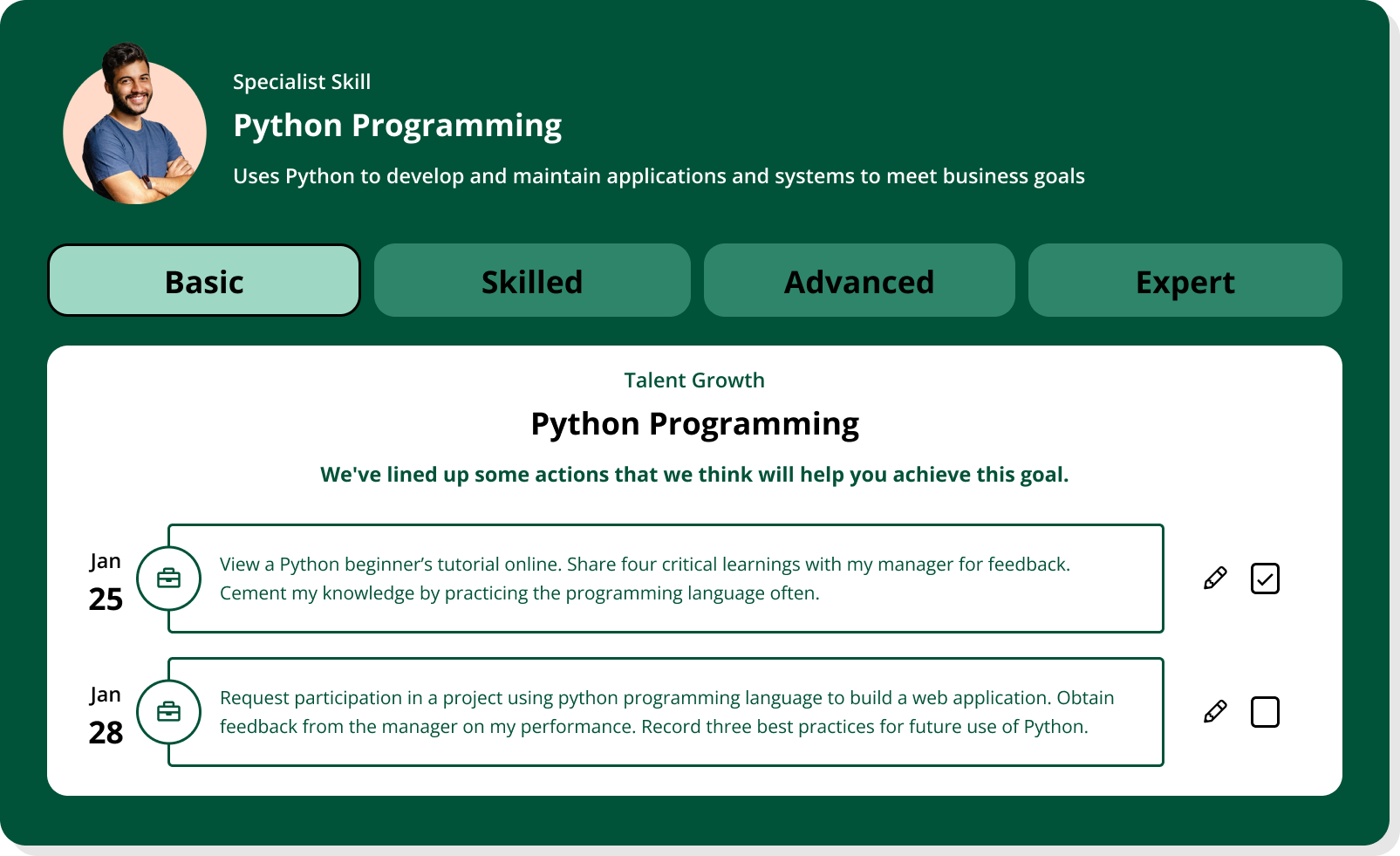A competency model is a structured framework that defines the specific behaviors, attributes, and capabilities required for effective performance in a particular role or organization. Unlike traditional job descriptions that focus on responsibilities, competency models emphasize the underlying characteristics that drive success.
For instance, at a Fortune 500 company, rather than listing tasks like “manage team meetings,” a competency model would define success through competencies like “strategic thinking,” “emotional intelligence,” and “change management.”
These models typically group competencies into clusters like “leadership,” “interpersonal,” and “technical,” creating a blueprint for evaluation and development.
What distinguishes competency models from other job analysis approaches is their person-centered rather than position-centered perspective. While job analysis examines what tasks need completion, competency models explore how high performers accomplish these responsibilities differently than average performers.
Competency models vs. skills: What’s the difference?
A common misconception is to confuse competency models with skills.
Skills are specific, teachable abilities that enable task completion, such as coding in Python, creating financial projections, or operating a specific piece of machinery. They’re typically binary (you either can or cannot perform them) and have clear pathways for development.
Competencies, meanwhile, encompass a broader spectrum of attributes, including knowledge, behaviors, motivations, and personal characteristics. “Creative problem-solving,” for instance, is a competency that might incorporate analytical reasoning skills, cognitive flexibility, risk tolerance, and pattern recognition.
This distinction matters because organizations often deploy the wrong solutions for their actual needs. When a company struggling with digital transformation builds an elaborate “digital leadership competency model” instead of addressing specific technical skill gaps, they place a complex framework over what might require more straightforward skill development.
In case you’re still unsure about what defines skills, here are a few attributes:
- Skills provide discrete, measurable units of capability: Unlike the abstract nature of competencies, skills represent specific, identifiable abilities that can be clearly assessed. A marketing analyst either can or cannot perform regression analysis—that clarity eliminates the subjective interpretation that plagues competency assessments, where managers might disagree on what constitutes “analytical thinking.”
- Skills transcend organizational boundaries: When companies catalog skills independently from roles or departments, they gain unprecedented visibility into their capability landscape. This cross-organizational standardization means a data visualization skill in marketing becomes comparable to the same skill in finance, enabling workforce planning that competency models can’t support.
- Skills adapt rapidly to market changes: While competency models require extensive redesigns when business strategies shift, skills frameworks can incorporate emerging capabilities quickly. When artificial intelligence emerged as a critical business driver, organizations with skills-based approaches could immediately identify and address capability gaps, rather than undertaking lengthy competency model revisions.
- Skills power effective talent marketplaces: The algorithmic matching at the heart of modern talent marketplaces depends on discrete skills data. With their role- or function-specific definitions, competency models create artificial barriers to talent mobility. Skills break free of those silos and allow organizations to match capabilities to opportunities regardless of departmental boundaries.
- Skills reveal hidden talent: By cataloging skills rather than competencies, organizations frequently discover capabilities they didn’t know existed in their workforce.
- Skills enable precision deployment: During business transformations or crisis response, organizations must quickly identify who can perform specific functions. When a global manufacturer needed to shift production rapidly during supply chain disruptions, they relied on skills data, not competency assessments, to identify employees who could step into critical roles within days.
- Skills create direct pathways to development: When an employee needs to work on their project management abilities, organizations can provide learning interventions for specific skills like “stakeholder management,” “critical path analysis,” or “resource allocation.” Competencies offer no such precision, leaving development efforts unfocused and their impact unmeasurable.
- Skills development shows clear progression: Organizations can measure skill proficiency along concrete scales to create transparent advancement pathways. Employees can see exactly what skills they need to hone for career progression, rather than wrestling with ambiguous competency requirements.
- Skills connect to business outcomes: The specificity of skills allows organizations to link capability development directly to performance metrics.
Five types of competency models and their applications
Organizations have developed various approaches to competency modeling, each with distinct strengths and limitations.
Organizational core competency models
These enterprise-wide frameworks define competencies expected of all employees regardless of role or level. They typically reflect the organization’s values and culture.
As an example, a healthcare organization might establish core competencies like “patient-centered care,” “ethical practice,” and “continuous improvement” that apply to frontline staff and executives alike.
Functional/Technical competency models
These models outline the specific technical competencies required for functions like marketing, finance, or operations.
For example, an IT function could outline competencies around “systems architecture,” “cybersecurity,” and “agile methodology” that span multiple roles within the department.
Leadership competencies models
These frameworks focus specifically on leadership capabilities required at various levels, typically becoming more strategic and complex as seniority increases.
An example would be a leadership model that defines “team leadership” at the supervisor level and evolves to “organizational leadership” and “industry leadership” for executives.
Role-specific competency models
These detailed models define success for particular positions, combining technical, behavioral, and cognitive competencies necessary for a given role.
As an example, a “customer success manager” model may include competencies for relationship management, product knowledge, conflict resolution, and business acumen.
Career progression competency models
These frameworks outline how competencies evolve across career stages, showing progression paths and development requirements for advancement.
For example, a professional services firm could show how “client management” evolves from supporting client meetings as an associate to managing complex client relationships as a partner.
How do competency models fit into the modern workplace?
Although competency models helped organizations standardize talent practices in the past, today’s workforce needs frameworks that match the speed, complexity, and fluidity of modern business. The stable, predictable environment that nurtured competency models has been replaced by an environment of continuous disruption, where skills become obsolete in mere years rather than decades, and organizational structures transform rapidly to meet market demands.
Companies once operated with relatively stable job structures and predictable career paths, but modern work increasingly occurs through projects, cross-functional initiatives, and agile teams that form and dissolve based on immediate business needs. Competency models, with their emphasis on broad, relatively static attributes arranged by job families or organizational levels, struggle to provide the precision necessary for this dynamic environment.
Skills frameworks provide a compelling alternative: Unlike the broad categories of competencies, skills represent discrete, specific capabilities that companies can clearly identify, measure, and deploy where needed. That precision allows for targeted talent decisions, rather than relying on approximations.
Skills-based approaches inherently support organizational boundary-crossing since skills remain consistent regardless of where they appear in the company. For instance, data analysis in marketing functions the same way in operations or finance. This consistency allows talent to move fluidly across traditional departmental lines, supporting the project-based, matrix-oriented structures that increasingly dominate modern work.
The nature of skills also enables rapid adaptation as market needs evolve. Organizations can quickly identify emerging skills, incorporate them into their frameworks, and deploy learning resources to nuture them without waiting for comprehensive competency model revisions. That adaptability creates unprecedented responsiveness to changing business requirements.
For employees, skills frameworks offer transparent pathways for growth that competency models rarely achieve. Rather than wrestling with abstract notions of what constitutes “leadership presence” or “strategic thinking,” employees can pinpoint specific skills they need and take concrete steps to acquire them. This clarity drives engagement, particularly among younger workers who prioritize development opportunities in their employment decisions.
How Fuel50 can help you become a skills-based organization
Altering an organization’s mindset can seem daunting, but a skills-backed talent marketplace is a powerful tool that can support these changes and make the transition is as seamless as possible.
As a result, your organization will build the agility it needs to keep up with the rapid changes we face today and in the future.
Here’s how Fuel50’s talent marketplace tool can help you:
Create a dynamic skills inventory with expert-driven skills ontology
A skills-based transformation necessitates a sophisticated understanding of skills. Fuel50’s advanced skills ontology transcends traditional taxonomies by providing a living, breathing ecosystem of over 5,000 unique capabilities, specialist skills, and tools.
This isn’t just another skills database—it’s a carefully curated framework developed by I/O psychology experts that grows and evolves with your organization.
What sets Fuel50’s skills ontology apart is its depth and practicality. Each skill comes with clear definitions and outcome-focused proficiency level descriptors, removing the ambiguity that often plagues skills assessment.
The system also includes suggested development actions for each skill, making it actionable for both employees and managers. Moreover, built-in bias checks ensure inclusivity and fairness, while continuous updates reflect emerging skills and market trends.
Enable data-driven skills insights
On the journey to become a skills-based organization, visibility is crucial. Fuel50’s analytics capabilities provide unprecedented insights into your company’s skills landscape. This goes beyond simple mapping to offer real-time understanding of skills distribution, critical gaps, and future needs based on market trends.
CarTrawler’s experience illustrates the power of these insights: By leveraging Fuel50, they assessed over 2,800 skills across their organization, enabling them to make informed decisions about talent development and deployment. That level of visibility helped them transition from intuition-based to data-driven talent decisions.
Foster internal mobility through AI-powered matching
A skills-based organization truly shines through its ability to deploy talent flexibly. Fuel50’s talent marketplace uses sophisticated AI to connect skills to opportunities in ways that traditional, job-based systems can’t.
The system considers both current skills and growth potential to enable cross-functional moves that a traditional organizational structure might overlook.
UCI’s experience demonstrates the impact of this approach: After implementing Fuel50’s talent marketplace, they achieved a 50% reduction in attrition. This dramatic improvement came from giving employees visibility into opportunities they might never have discovered in a typical, job-based system.
Support skills-based career development
Shifting to a skills-based approach requires companies to empower employees to take charge of their own development.
Fuel50 makes this possible by providing comprehensive career development tools that focus on skills rather than traditional job ladders. The platform offers sophisticated skills assessments, visibility into in-demand skills, and customized learning recommendations.
KeyBank’s success story proves the efficacy of this approach: They achieved a remarkable 72% user return rate on their Fuel50 platform, showing that employees actively engage with skills-based career development when given the right tools and support.
Enable skills-based workforce planning
Strategic workforce planning takes on new dimensions in a skills-based organization. Fuel50 provides leaders with powerful tools to understand their current skills landscape and prepare for future needs.
The platform enables sophisticated skills gap analysis at both organizational and team levels, while predictive analytics help identify emerging skill needs before they become critical gaps.
This capability proved transformative for organizations like Allied Irish Banks, which used Fuel50 to achieve a 96% return user rate and significantly improve their ability to anticipate future skill needs.
Facilitate cultural transformation
Perhaps most importantly, Fuel50 supports the cultural transformation required to become a skills-based organization.
More than implementing new technology, you need to change how people think about work, careers, and development.
The platform offers comprehensive change management support to help organizations communicate the value of skills-based approaches and demonstrate their impact through meaningful metrics.
Texas Health Resources exemplifies this transformative journey: Through their CareerDrive portal, powered by Fuel50, they achieved a 91% satisfaction rate, demonstrating how the right platform can drive widespread adoption of skills-based practices.
If you want to learn more about how Fuel50 can help you transform into a skills-based organization, request a demo here.















